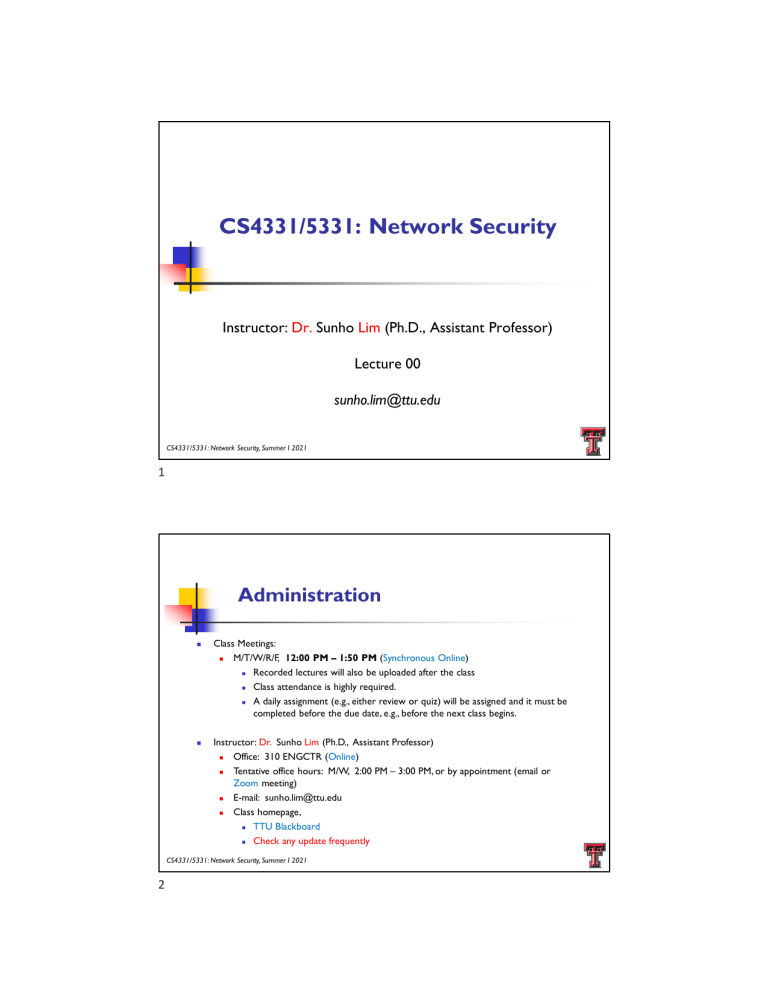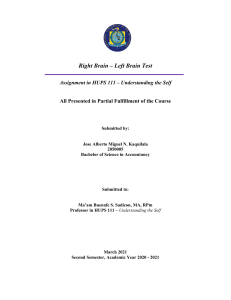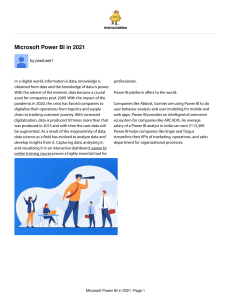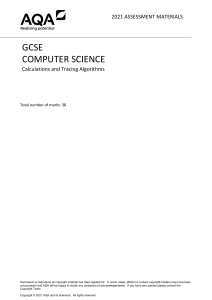
CS4331/5331: Network Security Instructor: Dr. Sunho Lim (Ph.D., Assistant Professor) Lecture 00 sunho.lim@ttu.edu CS4331/5331: Network Security, Summer I 2021 1 Administration Class Meetings: M/T/W/R/F, 12:00 PM – 1:50 PM (Synchronous Online) Recorded lectures will also be uploaded after the class Class attendance is highly required. A daily assignment (e.g., either review or quiz) will be assigned and it must be completed before the due date, e.g., before the next class begins. Instructor: Dr. Sunho Lim (Ph.D., Assistant Professor) Office: 310 ENGCTR (Online) Tentative office hours: M/W, 2:00 PM – 3:00 PM, or by appointment (email or Zoom meeting) E-mail: sunho.lim@ttu.edu Class homepage, TTU Blackboard Check any update frequently CS4331/5331: Network Security, Summer I 2021 2 Administration (cont.) Class homepage, TTU Blackboard “Summer 2021 TTU - CS-4331-102 & CS-5331-102 & CS-5331-D02” Check any update frequently Announcement Post and email broadcasted from TTU Blackboard Syllabus Lecture Note Recorded lecture Homework Submit through TTU Blackboard Quiz & Exam Quiz/Review/Exam Submit through TTU Blackboard Zoom CS4331/5331: Network Security, Summer I 2021 3 Administration (cont.) Required Textbook: No required textbook but a couple of reference books will be used Highly recommend: Computer Networking – A Top-Down Approach, by J. F. Kurose and K. W. Ross, 7th Edition, Pearson Important concepts/materials will be included in the lecture notes from various sources. CS4331/5331: Network Security, Summer I 2021 4 Administration (cont.) References: Network Security Essentials – Applications and Standards, 6th Edition, W. Stallings, Pearson Cryptography and Network Security – Principles and Practices, 4th Edition, W. Stallings, Pearson CS4331/5331: Network Security, Summer I 2021 5 Administration (cont.) References: (cont.) Network Security – Private Communication in a Public World, 2nd Edition, C. Kaufman, R. Perlman, and M. Speciner, Person Internet Security: A Hands-on Approach, 2nd Edition, W. Du Additional references or materials will be included in the lecture note, or uploaded in the Blackboard CS4331/5331: Network Security, Summer I 2021 6 Course Description Description: This course will introduce the basic security risks, threats, countermeasures, and applications in infrastructure-based networks. We will focus on the algorithms and communication protocols embedded in the level of the link, network, transport, and application layers. Objectives: The primary objective of this course is to introduce students the fundamental principles of network security and its related techniques in infrastructure-based networks. Prerequisites: Good background in computer science, good programming skill (e.g., Python or C), or permission from the instructor CS4331/5331: Network Security, Summer I 2021 7 Tentative Course Outline Introduction of Network Security Basic Cryptography Authentication and Integrity Secure Email Secure Socket Layer IPsec Intruder Detection Firewalls Wireless Security CS4331/5331: Network Security, Summer I 2021 8 Grading Policy No make-up exam/quiz! Midterm Exam: 20% June 15th (Tuesday), 12:00 PM – 1:50 PM, online Final Exam: 30% July 2nd (Friday), 11:00 AM – 1:30 PM, online Quiz/Review: 20% Quiz/Review may not be announced in advance Homework: 30% Late homework/quiz/review will NOT be accepted: Grade A (90 – 100), B (80 - 89), C (70 - 79), D (60 - 69), and F (0 - 59) CS4331/5331: Network Security, Summer I 2021 9 In addition, Utilize office hours Instructor: M/W 2:00 PM - 3:00 PM, by appointment (Email or Zoom meeting) TA: Mahfuzur Rahman <mahfrahm@ttu.edu> When you send an email, Please use the course number, e.g., CS4331/5331, in the title Must use TTU email account CS4331/5331: Network Security, Summer I 2021 10 Basic Infrastructure-based Networks Instructor: Dr. Sunho Lim (Ph.D., Assistant Professor) Lecture 01 sunho.lim@ttu.edu Adapted partially from Computer Networking – A Top-Down Approach, by J. F. Kurose and K. W. Ross, 7th Edition, Pearson CS4331/5331: Network Security, Summer I 2021 11 What’s the Internet: “Nuts and Bolts” View 螺母和螺栓,指具体内容 PC server millions of connected computing devices: hosts = end systems running application programs wireless laptop cellular handheld communication links fiber, copper, radio, satellite access transmission rate = points bandwidth wired links router routers: forward packets (chunks of data) CS4331/5331: Network Security, Summer I 2021 12 Mobile network Global ISP Home network Regional ISP Institutional network What’s the Internet: “Nuts and Bolts” View (cont.) Mobile network protocols control sending, receiving of msgs e.g., TCP, IP, HTTP, Ethernet, etc. Internet: “network of networks” loosely hierarchical public Internet versus private intranet Global ISP Home network Regional ISP Internet standards RFC: Request for comments IETF: Internet Engineering Task Force Institutional network CS4331/5331: Network Security, Summer I 2021 13 What’s the Internet: A Service View Mobile network communication infrastructure enables distributed applications: Web, VoIP, email, games, e-commerce, file sharing communication services provided to apps: reliable data delivery from source to destination “best effort” (unreliable) data delivery CS4331/5331: Network Security, Summer I 2021 14 Global ISP Home network Regional ISP Institutional network Protocol? A network protocol defines the format, order of msgs sent and received among network entities, and actions taken on msg transmission, and/or receipt of a msg or other event. network protocols: machines rather than humans all communication activity in Internet governed by protocols human protocols: “what’s the time?” “I have a question” introductions … specific msgs sent … specific actions taken when msgs received, or other events Hi TCP connection request TCP connection response Hi Get http://www.awl.com/kurose-ross Got the time? 2:00 <file> time CS4331/5331: Network Security, Summer I 2021 Q: a protocol for cutting a pizza equally? 15 Processor Vs. Process Multi-programming Single CPU with multiple programs? The OS creates a PROCESS for each program Control the switching of these processes What is a process? The execution in program! ??? ACTIVITY!! CS4331/5331: Network Security, Summer I 2021 16 Network Structure network edge: hosts: clients and servers servers often in data centers access networks, physical media: wired, wireless communication links connect an end system to the first router network core: interconnected routers network of networks CS4331/5331: Network Security, Summer I 2021 17 Network Structure: The Network Edge end systems (hosts): run application programs e.g. Web, email at “edge of network” client/server model client host requests, receives service from always-on server e.g. Web browser/server; email client/server peer-peer model: minimal (or no) use of dedicated servers e.g. Skype, BitTorrent CS4331/5331: Network Security, Summer I 2021 18 peer-peer client/server Access Networks and Physical Media Q: How to connect end systems to edge router? physical medium residential access nets – e.g., coaxial cable institutional access networks (school, company) – e.g., fiber optics mobile access networks – e.g., radio channels Keep in mind: bandwidth (bits per second) of access network? shared or dedicated? CS4331/5331: Network Security, Summer I 2021 19 Access Networks and Physical Media: Sending Packets of Data host sending function: take application message break into smaller chunks, known as packets, of length L bits transmits packet into access network at transmission rate R link transmission rate, a.k.a., link capacity, or link bandwidth two packets, L bits each 2 1 R: link transmission rate host packet transmission delay = time needed to transmit L-bit packet into link = L (bits) R (bits/sec) 1-20 CS4331/5331: Network Security, Summer I 2021 20 Why Layering? dealing with complex systems explicit structure allows identification, relationship of complex system’s pieces modularization eases maintenance, updating of system change of implementation of layer’s service is transparent to the rest of system layering – potential drawback? one layer may duplicate low-layer functionality functionality at one layer may need information in another layer violate the goal of separation of layers CS4331/5331: Network Security, Summer I 2021 21 Layering of Airline Functionality ticket (purchase) ticket (complain) baggage (check) baggage (claim gates (load) gates (unload) gate runway (takeoff) runway (land) takeoff/landing airplane routing airplane routing airplane routing departure airport airplane routing airplane routing intermediate air-traffic control centers arrival airport Layers: each layer implements a service via its own internal-layer actions relying on services provided by layer below CS4331/5331: Network Security, Summer I 2021 22 ticket baggage Internet Protocol Stack Application: supporting network applications FTP, SMTP, HTTP Transport: process-process data transfer TCP, UDP Network: routing of datagrams from source to destination IP, routing protocols Link: data transfer between neighboring network elements PPP, Ethernet Physical: bits “on the wire” application transport network link physical CS4331/5331: Network Security, Summer I 2021 23 source message segment M Ht M datagram Hn Ht M frame Hl Hn Ht M application transport network link physical Encapsulation link physical switch destination M Ht M Hn Ht M Hl Hn Ht M application transport network link physical CS4331/5331: Network Security, Summer I 2021 24 Hn Ht M Hl Hn Ht M network link physical Hn Ht M router Encapsulation (cont.) source message segment datagram frame M Ht M Hn Ht M Hl Hn Ht M application transport network link physical link physical switch M Ht M Hn Ht M Hl Hn Ht M destination Hn Ht M application transport network link physical Hl Hn Ht M network link physical Hn Ht router CS4331/5331: Network Security, Summer I 2021 25 Another Simple Reference Model Application Application Transport Transport Network Network Data Link Data Link Data Link Physical Physical Physical Physical CS4331/5331: Network Security, Summer I 2021 26 Network Network Data Link Radio M Medium








